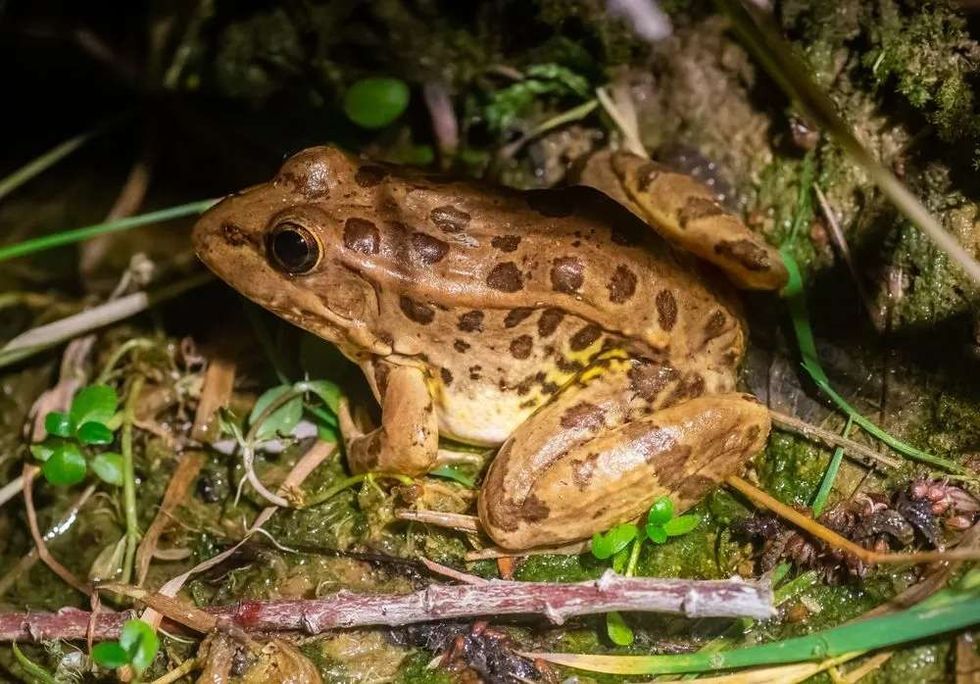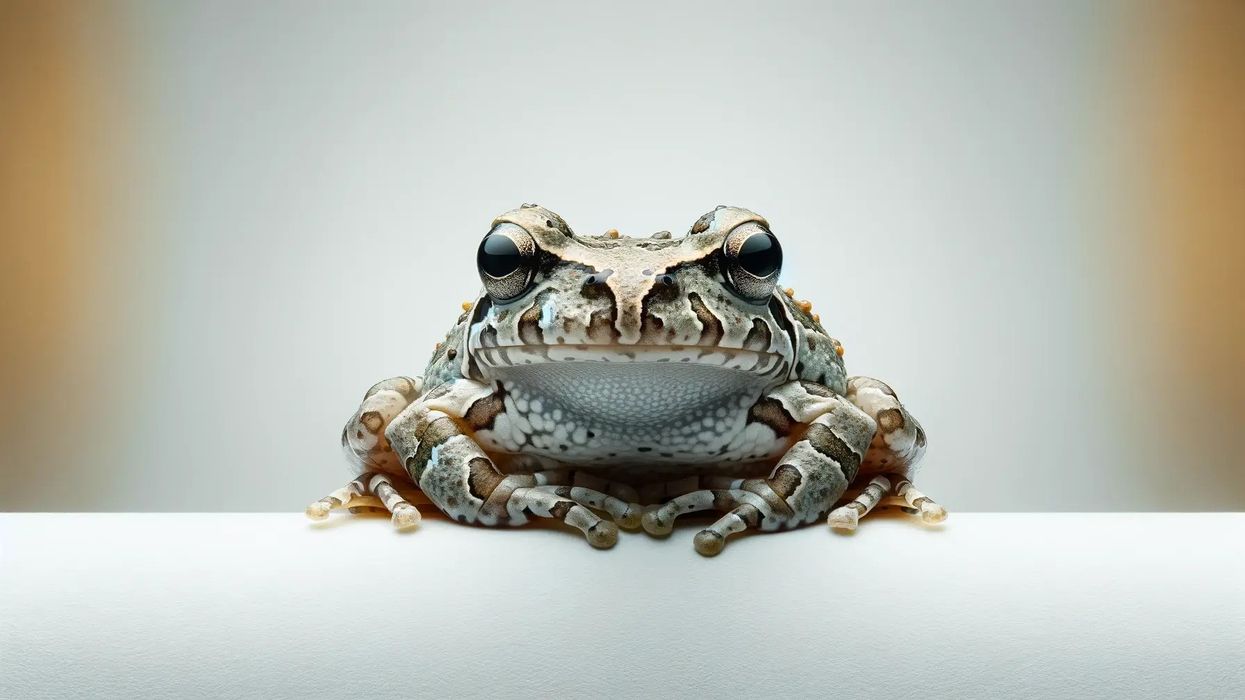The relict leopard frog (Lithobates onca) is an endangered frog species, found in parts of the United States.
This can range from Washington County, along the Virgin River, Overton Arm of Lake Mead to St. George in Utah, the Muddy River in Nevada, northwestern Arizona, and the Colorado River. The population of this species is down to 500 to 1100 adults and they could become a near extinct species if not preserved.
The main reason for the decline in numbers is the loss of habitat due to man-made infrastructure, river drainage, and the introduction of invasive or non-native fish species.
Relict leopard frogs are brown to gray and have large greenish spots shaped like leopard skin. A lot of states like Utah, Arizona, and Nevada are working hard to create proper conservative lands for this species. If you liked reading about the relict leopard frog, try checking out our articles on the African clawed frog and the poison frog.
Relict Leopard Frog Interesting Facts
What type of animal is a relict leopard frog?
The relict leopard frog (Rana onca) is a species of frog found in the United States. They are mostly found in the Colorado River, the Virgin River, and Lake Mead.
What class of animal does a relict leopard frog belong to?
The relict leopard frog (Lithobates onca) belongs to the class amphibian with the Lithobates genus of the Ranidae family.
How many relict leopard frogs are there in the world?
Only 500 to 1100 adult relict leopard frog species (Rana onca) remain in the world. They are an engendered species that is considered near extinct in most of their original habitat. The populations of these frogs keep decreasing due to loss of habitat, river drainage, destruction of natural springs, water development plans, and non-native animal species.
Where does the relict leopard frog live?
Relict leopard frog (Rana onca) populations are found in freshwater springs and creeks in the United States including northwestern Arizona, Washington County, Utah, California, Colorado River, Las Vegas Valley, the Muddy River in Nevada, and southwestern Utah. In Utah, they are found along the Virgin River, the Overton Arm of Lake Mead, and near St. George City.
What is a relict leopard frog's habitat?
The relict leopard frog habitat is mostly near water bodies like freshwater springs, creeks, and seeps at elevations of 1213-2493 ft (370-760 m). This species can also be found in clean streams, springs, and spring-fed wetlands.
Who do relict leopard frogs live with?
The relict leopard frogs species can live a solitary life and will be found with a partner mostly during the breeding season near springs or egg-laying sites.
How long does a relict leopard frog live?
The average lifespan of a relict leopard frog is not known as the populations are too little for observation. They may live for the same amount of years as other leopard frogs, which can be two to four years.
How do they reproduce?
Not much is known about the reproductive habits of the relict leopard frog species. The breeding season can range from January to April and egg-laying will take place in February or March. The egg-laying grounds should preferably be quiet pools or slow-moving streams. This species will lay up to 250 eggs in one season.
What is their conservation status?
The conservation status of relict leopard frogs is Endangered and if not protected, their populations could reach a near-extinct level. The main reason for the fall in their numbers is the loss of natural habitat, the draining of springs, river drainage to make agricultural land, water development projects, and other man-made infrastructure.
Conservative methods are in progress and the reintroduction of relict leopard frogs into natural springs began in Arizona and Utah in 2006.
Relict Leopard Frog Fun Facts
What do relict leopard frogs look like?
The relict leopard frog description is similar to other leopard frog species. Their skin color can range from brown to gray skin with distinct greenish-gray large spots throughout the body.
A large, light strip runs on each side of the body, and the undersides are white. This frog species also has dark spots on the throat and orange-yellow mottling on the underside of the hind limbs.
How cute are they?
Relict leopard frogs have a unique leopard print on their body and are very small in size. They are a very cute species and need immediate conservation efforts to save their populations from extinction.
How do they communicate?
The relict leopard frog species can communicate using vocal sounds, often known as frog croaks or 'ribbits'. They may also use body language like leg tapping as a means of communicating.
How big is a relict leopard frog?
Relict leopard frogs can range from 1.7-3.4 in (44-87 mm) in length. They are only about three times the size of a honeybee.
How fast can a relict leopard frog move?
There are no studies that estimate the speed of relict leopard frogs.
How much does a relict leopard frog weigh?
The average weight of the relict leopard frog species can range from 0.70-0.77 oz (20-22 g).
What are the male and female names of the species?
There are no names for the males and females of this species.
What would you call a baby relict leopard frog?
A relict leopard frog baby does not have a specified name.
What do they eat?
Relict leopard frogs are known to be carnivores and can eat various kinds of insects like spiders, crustaceans, and other small vertebrates. Their main predators include Colorado River herons, turtles, and snakes.
Are they poisonous?
They are not poisonous and are harmless to human beings. Relict leopard frogs tend to stick to their habitats and are not a pest of any kind.
Would they make a good pet?
No, the conservation status of this species is Endangered and their numbers are not stable. It may not be possible to own a near-extinct leopard frog and can be illegal in some areas where populations are particularly low.
Did you know...
The eggs of relict leopard frogs are attached to living or dead vegetation just below the surface of the water. Researchers from the University of Nevada, Las Vegas, and Nation Park Service are continuously trying to protect this species by building conservation grounds for them.
Why is the relict leopard frog endangered?
The relict leopard frog (Lithobates onca) is an Endangered species mainly because of the continuous loss of habitat. Their original habitat is being removed to make agricultural facilities or water development projects. Invasive species, predators, parasites, and diseases are also some other major reasons. Their population is still decreasing in numbers.
What eats the relict leopard frog?
The relict leopard frog species can be hunted by snakes, raccoons, turtles, and seabirds like herons.
Here at Kidadl, we have carefully created lots of interesting family-friendly animal facts for everyone to discover! Learn more about some other amphibians including common toads and axolotl.
You can even occupy yourself at home by coloring in one of our free printable relict leopard frog coloring pages.









